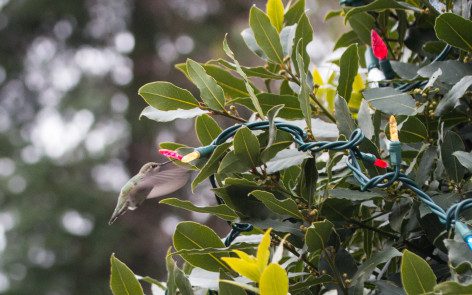Mike Morrell writes:
Our newest correspondent asked about Anna’s Hummingbirds (ANHU) on Denman. So I’ve done a quick review, which may be of general interest.
Until the mid-20th Century ANHU were restricted to chaparral habitat in northern Baja California and southern Calif, where it depended largely on wild currants and gooseberries. Widespread planting of eucalyptus and other non-native plants appears to have facilitated a significant range expansion north and east. Their geographic expansion is almost certainly related to the advent of hummingbird feeders and garden plantings of exotic flowers; overwintering birds in BC must depend on feeders, though they also feed on spiders, insects and winter-flowering plants. ANHU were first confirmed in Oregon and Washington in 1964 and in BC in 1958 (breeding record south Vancouver Is).
They may have appeared on southern Vancouver Island as early as 1944 but were simply reported as “unidentified hummingbirds”, noteworthy by their occurrence in winter, when the native Rufous are normally absent. They were first recorded in the lower mainland in 1959. In BC sightings increased after 1970, mostly from extreme southern Vancouver Island. The first interior record was from the Okanagan in 1974. In 1975 one was reported from Terrace.
ANHU were first reported on the Comox Christmas Bird Count in 1973 and were recorded sporadically in subsequent years; since 2004 they’ve been on the count every year. On Denman Island the first positive record I know of was by Jenny Balke in Nov 2008, though they were likely here somewhat earlier. We first had them on our Xmas Count in 2008 and have recorded them on the count every year since 2010: 9 in 2014 and 11 in 2016. There have now been several breeding records on Denman, and they’re now resident here. By the criteria of the Comox Valley Checklist I’d consider them uncommon to fairly common—i.e. regular but rather local and sometimes difficult to locate.
Karen asked about interactions between Anna’s and the native Rufous Hummingbirds. Rufous are known for their aggressive defense of feeding territories and normally dominate Anna’s where they are using the same feeders. Anna’s may have a bit of an advantage by virtue of being able to overwinter, so they are already established when the migrant Rufous arrive in late Mar and early Apr, by which time Anna’s are already incubating eggs and alternative food sources are available. Apparently the two species are able to co-exist, though I’ve seen no studies of the effects of possible competition.
Happy spring birding—new migrants every day. Keep an eye out for warblers, early flycatchers and sandpipers.



Mike Morrell adds: A recent article in Proceeding of the Royal Society (UK) uses Feeder Watch data to examine possible causes of the recent range extensions of Anna’s Hummingbird in North America.
From the abstract:
“Using 17 years of data from the citizen science programme Project FeederWatch, we examined the relationships between urbanization, winter temperatures and the availability of supplementary food (i.e. artificial nectar) on the winter range expansion (more than 700 km northward in the past two decades) of Anna’s hummingbirds (Calypte anna). We found that Anna’s hummingbirds have colonized colder locations over time, were more likely to colonize sites with higher housing density and were more likely to visit feeders in the expanded range compared to the historical range. Additionally, their range expansion mirrored a corresponding increase over time in the tendency of people to provide nectar feeders in the expanded range.”